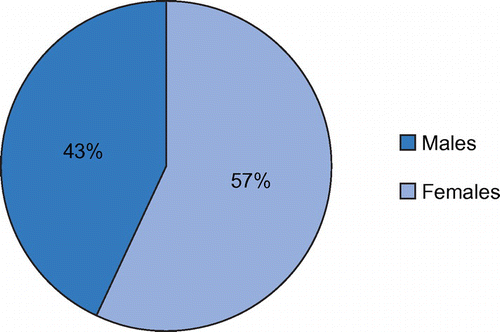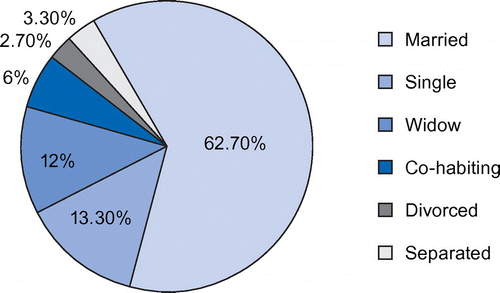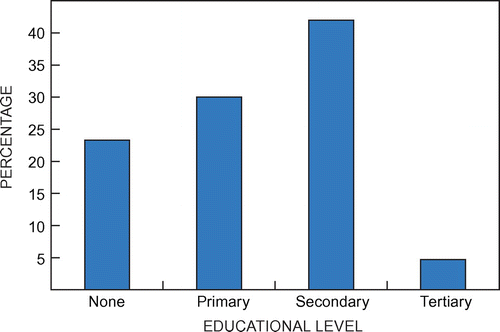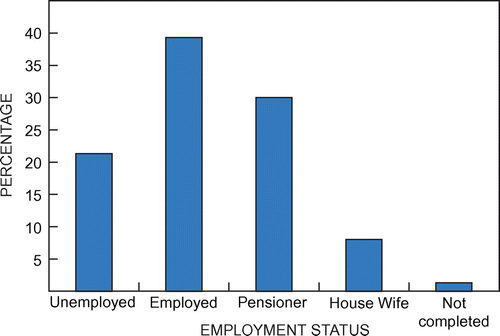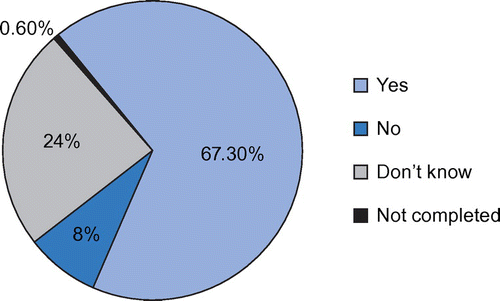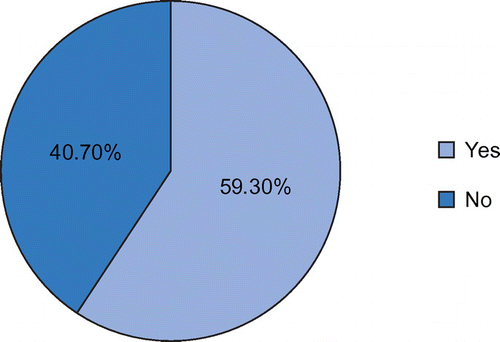Abstract
Introduction: Diabetes mellitus is one of the most common clinical conditions seen by family physicians in their daily practice. They are constantly confronted with the burden of caring for poorly controlled and poorly adherent patients presenting with preventable debilitating, disabling and mutilating complications. Lifestyle modifications in combination with medications have been proven to contribute to the prevention and delay of complications.
Aims: The study aimed to investigate the knowledge and practice of lifestyle modifications and also to determine challenges faced by patients in their practice of lifestyle changes in the management of type 2 diabetes mellitus in the Middelburg sub-district of Mpumalanga.
Study design: An observational, descriptive and cross-sectional study was done. Data were collected from 150 patients with type 2 diabetes mellitus (T2DM) using a self-administered questionnaire.
Results: The results showed that DM was more prevalent among females and the age group 50– 59 years was mostly affected. Nearly 50% of the respondents were obese and about 35% of them overweight. Lifestyle modification was understood as healthy dietary habits. Only 35% of the respondents participated in exercises. Brisk walking (59%) was the preferred form of exercise among these participants. A statistically significant finding was that 79.63% of participants who did not adhere to exercise recommendations had poor glycaemic control. Only 40.48% of participants who adhered to exercise recommendations had good glycaemic control. Obesity (47.52%) and overweight (32.67%) were associated with poor glycaemic control.
Conclusion and recommendation: The majority of the participants thought that lifestyle modification was healthy eating; only a third of them regularly exercised. The author recommends a multidisciplinary and multilevel approach involving different stakeholders— among others, patients and community, health professionals/providers and government services—in assisting diabetic patients with lifestyle modification.
Introduction
Diabetes mellitus is one of the most common clinical conditions seen by family physicians in their daily practiceCitation.1 Family physicians are frequently confronted with the burden of caring for poorly controlled and poorly adherent patients presenting with preventable debilitating, disabling and mutilating complicationsCitation.1
T2DM constitutes about 90–95% of all diabetesCitation1,2 in developed countries and accounts for even a higher percentage in developing countries.
The reason for this project was an observation by the researcher, at Middelburg hospital and some of the local clinics around Middelburg sub-district, that most patients with type 2 diabetes mellitus (T2DM) presented with poor glycaemic control, despite good adherence to drugs treatment. Studies have shown that lifestyle modifications are the cornerstone of T2DM managementCitation.1,2
The study aimed to investigate the knowledge and practice of lifestyle modifications in patients with type 2 diabetes mellitus in the Middelburg sub-district of Mpumalanga and also to determine challenges faced by patients in their practice of lifestyle changes in the management of T2DM.
Methodology
The study was observational, descriptive and cross-sectional. All patients with T2DM who presented at the health facility during the study period (November 1, 2013–February 28, 2014) formed the study population. The study was conducted in the outpatient department at Middelburg hospital and the primary health care (PHC) facilities in the sub-district. A convenience sampling method, where data were collected from the first two patients of the day in all the facilities, was used to select 40 subjects per month, over a period of four months. A total of 160 participants were recruited into the study. A sample size of 150 was planned, which estimated the expected proportion of 67% of patients with poor knowledge to an accuracy of 7.5% with 95% confidence. This sample size was also sufficient for addressing the relationship between glycaemic control or adherence to lifestyle modifications with the determinant knowledge and demographics. The first 150 participants were selected for the study. Data were collected throughout the study period using a self-administered questionnaire (in this study, a previously used questionnaire in a peer-reviewed journalCitation3 was adapted and used for our context and validation) for participants who could read and write. Other participants were assisted by medical officers, clinical associate students and nurses consulting in the outpatient department at Middelburg hospital and the primary health care facilities in the sub-district. Patients with newly diagnosed T2DM (< 6 months) and those living with type 1 diabetes mellitus were excluded from the study. The information obtained from the questionnaires was captured on a Microsoft Excel® (Microsoft Corp, Redmond, WA, USA) sheet. Data were edited and analysed using the chi-square test (Fisher’s exact) and data summary included frequencies, percentages, cross-tables and 95% confidence intervals. This was done with the assistance of a biostatistician from the Medical Research Council, Pretoria. The proportion of patients with poor knowledge (not knowing the positive effects of regular physical activity, quitting smoking, weight loss for overweight or obese patient and diet changes in management of T2DM) or who know only one or two of the above factors was reported as a percentage with a 95% confidence interval. The association of the outcome variables, poor glycaemic control and non-adherence to lifestyle modifications, with poor knowledge and demographic variables was assessed using logistic regression and the statistics of interest was adjusted odd ratios with 95% confidence intervals. Testing was done at the 0.05 level of significance.
Ethical considerations
Ethical approval to carry out the research was obtained from the Faculty of Health Sciences’ Ethics Committee, University of Pretoria (ethics reference no. 389/2013).
Results of study
The results are presented, starting with demographics of the participants followed by specific results comprising the knowledge, practice and perception related to lifestyle modification and are expressed in frequency, row percentage or column percentage.
Demographic data
Gender distribution
Figure represents the gender distribution of the participants. It shows that most of the respondents were females (57%) as compared with males (43%).
Age groups of the respondents
Ages of the respondents are reported in groups as shown in Table , demonstrating that 36.7% of the respondents were aged 50–59 years.
Table 1: Age groups
Body mass index
The participants’ body mass indices appear in Figure This indicates that most of the respondents were obese (47.18%; BMI ≥ 30).
Marital status
Figure shows the marital status of the participants: 62.7% of the respondents were married and 18% were separated (widowed, divorced, separated).
Employment status
The employment status of participants is shown in Figure . In total, 39.3% of respondents were employed.
Understanding of lifestyle modification
Table shows participants’ understanding of lifestyle modification, and indicates that 34% of the respondents understood lifestyle modification as engaging in regular aerobic exercise and healthy dietary habits while 21.33% considered this to be healthy dietary habits only.
Table 2: Understanding of lifestyle modification
Three questionnaires in this section were not completed, comprising a total of 2%, which may be negligible in terms of contributing any meaningful findings to the study.
Perception of exercise in controlling diabetes mellitus
Participants’ perception of exercise in controlling DM is shown in Figure . Some 67.3% of respondents had a perception that exercise could help to control diabetes mellitus (DM).
Participation in exercise
Figure shows adherence to exercise, and denotes that 59.3% of respondents adhered to exercise.
Association between adherence to exercise and glycaemic control
The association between adherence to exercise and glycaemic control is given in Table . This shows that 79.63% of respondents with poor adherence to exercise recommendation (n = 111, 79.63%; 95% CI 1.134–5.565) had poor glycaemic control.
Table 3: Association between adherence to exercise and glycaemic control
Employment status and glycaemic control
The influence of employment status on glycaemic control is presented in Table . No association between employment status and glycaemic control was found that was statistically significant (p = 0.303). Unemployed respondents (n = 91, 35.71%; CI = 0.237–1.566) had poor glycaemic control.
Table 4: Employment status and glycaemic control
Discussion
Demographics
Among the 150 participants, 43% were males and 57% were females. As is evident, the majority of participants were females, as has been reported in previous studies on this subject: Ganiyu et al. reported 58.7% of female participantsCitation3 and in Nigeria, Ekpenyong et al. reported 56.2% as being female.Citation4
The youngest participant was 22 years and the oldest was 83 years with a mean age of 56.7 years. The majority of the participants (36.7%) were aged 50–59 years followed by the age group 60–69 years (23.3%) and 20.7% for age group 40–49 years. This observation concurred with the study by Ganiyu et al. that reported 50–59 years (26.9%) as comprising the majority of participants.Citation3
A report by the Medical Research Council of South Africa showed that 61% of the South African population were overweight, obese or morbidly obese and that 70% of women over the age of 35 years were overweight or obese.Citation5 The present study found that 44.6% of participants were obese and 33.3% were overweight.
It was found that married participants constituted 62.7% of the study population while 13.3% were single (widowed, divorced or separated). A similar study by Ganiyu et al. reported that 41.3% of participants were married, 14.4% co-habiting and 26% were single.Citation3
The majority of the participants had secondary education (42%) while only 4.67% had tertiary education. Ntambwe reported a similar finding in Ermelo, Mpumalanga Province where 8% of the participants had tertiary education and 37% had secondary education.Citation6
The study revealed that 39.3% of participants were employed, 21.3% unemployed and 30% were pensioners.
Specifics related to lifestyle modification to control diabetes
Understanding lifestyle modification
The study found that 34% of the participants understood (perception) lifestyle modification as engaging in regular aerobic exercise and healthy dietary habit only. Another 22% perceived this as regular aerobic exercise, healthy dietary habit, moderate alcohol consumption and smoking cessation. A total of 60% had a good knowledge of lifestyle modification recommendations. However, in a study conducted in Nigeria by Odenigbo et al., it was reported that 57% of participants had poor knowledge and 51% had poor practices of lifestyle modification.Citation7
Perception of exercise in controlling diabetes mellitus
The study showed that 67.3% of participants had a perception that regular aerobic exercise helps to control and maintain glucose level. This finding concurred with the report by Ganiyu et al., which also showed 67.3%.Citation3
Participation and adherence to exercise
Among the study participants, 105 reported participating in exercise. Among those who took part in exercise, 59.3% were adherent to aerobic exercise and 40.7% were not adherent to exercise. A study by Forkan et alCitation.8 demonstrated that 37% of their respondents did not exercise and also Nelson et al. reported 31% had no regular physical activity and 38% had less than the recommended level of physical activity.Citation9
Association between adherence to exercise and glycaemic control
The study found that among those who participated in exercise, the type of exercise mostly undertaken was brisk walking (59.1%), jogging (13.33%) and cycling (1.9%). The participants in this study reported the following as reasons for not adhering to exercise recommendation: too busy schedule (43.9%), no exercise partner (19.4%), stress (16.3%) and weather and no exercise partner (10.2%). Among the respondents who did not adhere to exercise, 79.63% had poor glycaemic control. With p = 0.023, there was a clear and statistically significant association between poor adherence to exercise and poor glycaemic control. This is in line with a study by Boule et al. that reported exercise training reduces HbA1c levels by an amount that should decrease the risk of diabetes complications.Citation10
Association between employment status and glycaemic control
The study showed that 39.33% of respondents were employed and 60.67% unemployed. Among those employed, 40% had poor glycaemic control as compared with 59.26% of unemployed participants who had poor glycaemic control. Although the association between employment status and glycaemic control was not statistically significant (p = 0.710), the finding is consistent with what Tang et al. found in Hong Kong. They reported that employed patients had better glycaemic control compared with the unemployed.Citation11
Conclusion and recommendations
Patients living with DM will have a better outcome of care if primary healthcare providers regularly and effectively advise them on lifestyle modifications and continue to emphasise their importance at every clinic visit. This should improve their knowledge and practice and ultimately lead to better control of blood sugar.
The study has shown that many patients with T2DM had poor glycaemic control. This, in turn, may lead to increased morbidity and mortality.
In order to address these problems, the author recommends a multidisciplinary and multilevel approach involving different stakeholders with specific tasks at various levels:
Patients and community: Pamphlets and leaflets with an emphasis on lifestyle recommendations must be provided not only to those living with DM, but to the community at large.Citation12
Healthcare providers: Healthcare workers must emphasise the importance of exercise in the management of diabetes mellitus at every encounter with the patient. The recommendations given must be adapted to the individual’s ability, needs and limitations.
Government: The government must create a conducive and supportive environment to promote physical activity and dietary education in the community and must encourage and support research on non-communicable chronic diseases of lifestyle in the district health system.
Strengths and limitations
The study was conducted in a primary care setting, and as such is relevant to the field of family medicine. However, the study does have some limitations. It was a self-reported study and the accuracy of the report could not be double-checked. Another limitation was that T2DM patients diagnosed less than six months before the study were excluded. Therefore, the findings of the study may not be generalised to the larger population of patients living with diabetes mellitus.
Funding
No potential conflict of interest was reported by the authors.
Notes
i This peer reviewed article is a summary of the MMed (Family Medicine) dissertation submitted by the first author. The second author was the supervisor.
References
- Hakan D, Illian S, Yildrum C, et al. Essentials of Diabetes Care in Family Practice [Internet]. 2013 [cited 2014 March 10]. Available from http://www.intechopen.com/books/diabetes-mellitus-insight-and-perspertives/essentials-of-diabetes-care-in-family-practice.
- Erasmus RT, Soita DJ, Hassan MS, et al. High prevalence of diabetes mellitus and metabolic syndrome in South Africa coloured population: Baseline data of a study in Bellville, Cape Town [Internet] 2012 [cited 2014 Mar 5]. Available from: http:// www.samj.org.za/index.php/samj/article/view/5670.
- Ganiyu A, Mabuza L, Malete N, et al. Non adherence to diet and exercise recommendations amongst patients with type 2 diabetes mellitus attending Extension 2 clinic in Botswana [Internet]. 2013 [cited 2014 September 13]. Available from: http://www.phcfm.org/doi:10.4102/phcfm.v5i1.457
- Ekpenyong C, Akpan U, Ibu J, et al. Gender and age specific prevalence and associated risk factors of type 2 diabetes mellitus in Uyo metropolis, South Eastern Nigeria [Internet]. 08 March 2012 [Cited 2014 July 26]. Available from: http://www.idb.hr/diabetologia/12no1-2.pdf
- Medical Research Council of South Africa. South Africa’s battle against the bulge [Internet]. 2013 [cited 2014 August 30]. Available from: www.smasa.cc/4th-post
- Ntambwe K. Prevalence and pattern of overweight and obesity among adult population attending the outpatient department of Ermelo Hospital [ Unpublished dissertation]. University of Pretoria; 2011.
- Odenigbo M, Inya-Osuu J, et al. Knowledge, attitude and practice of people with type 2 diabetes mellitus in a tertiary health care centre in Umuahia. Nigeria. J Diabetes Metabol [Internet]. 2012 [cited 2013 Jan 21]; 3:187. doi: 10.4172/2155-6156.1000187. Available from: http://www.omicsonline.org/2155-6156/2155-6156-3-187.Php
- Forkan R, Pumper B, Smyth N, et al. Exercise adherence following physical therapy intervention in older adults with impaired balance [Internet]. 2006 [cited 2014 September 3]. Available from: www.ptjournal.apta.org/content/86/3/401
- Nelson K, Reiber G, Boyko E. Diet and exercise among adults with type 2 diabetes; findings from the 3rd national health and nutrition examination survey [Internet]. 2002 [cited 2014 September 2]. Available from: www.care.diabetesjournals.org/contents/25/10/1722
- Boulé N, Haddad E, Kenny G, et al. Effect of exercise on glyceamic control and body mass in type 2 diabetes mellitus. JAMA [Internet]. 2001 [cited 2013 May 22]; 286(10):1218–1227. Available from: Google scholar.10.1001/jama.286.10.1218
- Tang Y, Pang S, Chan M, et al. Health literacy, complication awareness, and diabetic control in patients with type 2 diabetes mellitus [Internet]. 2008 [cited 2014 September 17]. Available from: http://0-onlinelibrary.wiley.com.innopac.up.ac.za/doi/10.1111/j.1365-2648.2007.04526.x/full
- Shah V, Kamdar P, Shah N. Assessing the knowledge, attitude and practice of type 2 diabetes among patients of Saurashtra region. Gujarat: Int J Diabetes Dev Ctries [Internet]. 2009 [cited 2013 Jan 21]; 29(3): 118–122. Available from: http://www.ncbi.nlm.nih.gov/pmc/articles/pmc2822215/.

